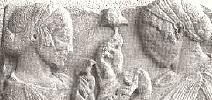The Mysteries of Eleusis
![]() Every Year,at time of the Eleusian festival, peace was declared througout Greece for fifty-five
days (Beck). Originally the festival was
held to ensure the growth of the grain. Neighboring cities were invited to join in the
festivities. Priests and priestesses led a grand procession on the day before the festival would
begin. The festival itself lasted for eight days and "all who could speek Greek (except murderers)
were eligible for initiation, including women and slaves" (Powell 239).
Every Year,at time of the Eleusian festival, peace was declared througout Greece for fifty-five
days (Beck). Originally the festival was
held to ensure the growth of the grain. Neighboring cities were invited to join in the
festivities. Priests and priestesses led a grand procession on the day before the festival would
begin. The festival itself lasted for eight days and "all who could speek Greek (except murderers)
were eligible for initiation, including women and slaves" (Powell 239).
Initiates were not allowed to say anything of what went on at the festival, and this secrecy was so well kept that today we know almost nothing about it. What we do know, however, is that one of the high points of the festival was the unveiling of an ear of grain (Spencer).
 On the sixth and seventh day the initiation proper took place. So far the initiates had fasted
but now they were offered the kykeon, a sacred drink. Some speculated that the
drink was spiced with a drug (Powell). Participants were sought to consume some sort of
mushroom to experience hallucinogenic effects (Spencer). Persephonê and Demeter hold something in their hand that looks very much like a mushroom in the image on the right.
On the sixth and seventh day the initiation proper took place. So far the initiates had fasted
but now they were offered the kykeon, a sacred drink. Some speculated that the
drink was spiced with a drug (Powell). Participants were sought to consume some sort of
mushroom to experience hallucinogenic effects (Spencer). Persephonê and Demeter hold something in their hand that looks very much like a mushroom in the image on the right.
Initiates were suposed to enter theTelesterion which was lit only by a fire and torches. Shrouded in darkness, they witnessed some terrifying things. "A flash of light burst from the Anaktoron, and the hierophant appeared from out of the Anaktoron in the radiant nights of the mysteries". At some point the hiera was shown and somebody said something, but we do not know what the hiera constituted nor do we know what was said (Powell 239-240). This must really be one of the best kept secret in the universe.
The whole myth surrounding Eleusis must be sought of in connection with Persenophê's return to Demeter. A person, however divine, is usually unable to break away from Hades' clasps and return to the living. Participants must have been overjoyed knowing of this possibility. Maybe Hades was not as strong and bad as they thought. Maybe living among the dead wasn't so bad after all. Demeter is a symbol of fertility and Persephonê is a symbol of death. Thus, the goddesses are symbols of the growing seasons and winter on earth.